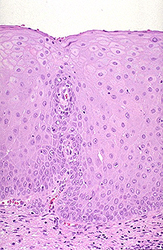Stratified squamous (nonkeratinized)
(Fig. 4-14)
- Scan the epithelium lining the
larynx (slide 7) and cornea (slide
78), observing the change to
stratified squamous epithelium in the larynx.
- This is an example of
nonkeratinized stratified squamous epithelium.
- Note: Flattened cells in
the superficial layers still have their nuclei.
What functional similarities
and what differences are indicated by the two types of epithelia
lining the larynx and trachea?
What happens when an epithelium is subjected to chronic stress or
injury?
- An epithelium usually maintains
the structure characteristic of the organ in which it is found,
but when subjected to prolonged irritation, it may become
transformed to a different type better suited to resist the
irritant. This is called epithelial metaplasia. This is a
defense mechanism in which the transformed epithelium is
sturdier and better able to withstand the chronic irritation.
- Examples include the
transformation of tracheal respiratory epithelium to
stratified squamous in heavy smokers and esophageal
stratified squamous epithelium to simple columnar
(mucus-secreting) epithelium in persons with chronic
gastro-esophageal reflux disorder.
Stratified
keratinized squamous epithelium. |